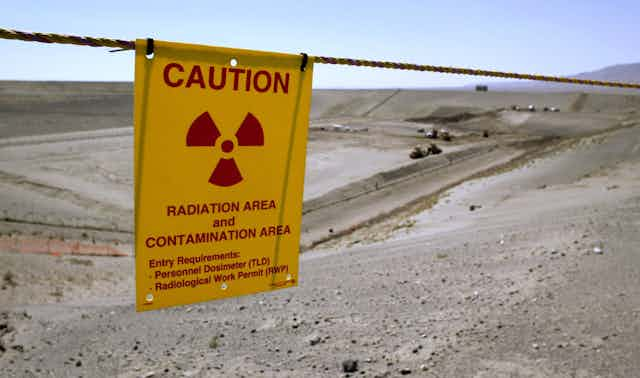During the 1960s, the Soviet Union and the United States came close to war over the Soviet’s attempt to install nuclear weapons in Cuba, 90 miles off the Florida coast.
People in the U.S. feared nuclear war. Children practiced nuclear drills hiding under their desks. Families built nuclear bunkers in their backyards.
But later in the 20th century, nuclear war became less likely. Countries committed to diminishing their stockpiles of nuclear weapons, or pledged to not pursue nuclear weapons in the first place.
Now, after decades of progress on limiting the buildup of nuclear weapons, Russia’s war on Ukraine has prompted renewed nuclear tensions between Russia and the U.S.
On Feb. 24, 2022, Russian president Vladimir Putin threatened that any country that interfered in Ukraine would “face consequences greater than any you have faced in history.” Many experts and observers interpreted this as a threat of nuclear attacks against Ukraine’s defenders.
A single nuclear weapon today in a major city could immediately kill anywhere from 52,000 to several million people, depending on the weapon’s size.
Understanding these new threats requires an understanding of efforts to reduce the number of nuclear weapons, prevent the spread of nuclear weapons to new countries and the development or stockpiling of nuclear weapons in different countries.
I have worked on and researched nuclear nonproliferation for two decades.
Convincing countries to reduce their nuclear weapon stockpiles or renounce the pursuit of this ultimate weapon has always been extremely difficult.

A history of nonproliferation
The Soviet Union, U.S., United Kingdom, France, Israel and China had active nuclear weapons programs in the 1960s.
Countries recognized the risk of a nuclear war in the future.
Sixty-two countries initially agreed to what’s been called the “Grand Bargain” in 1967, an essential element of the Treaty on the Nonproliferation of Nuclear Weapons. One hundred and ninety-one countries eventually signed this treaty.
The agreement prevented the spread of nuclear weapons to countries that didn’t already have them by 1967. Countries with nuclear weapons, like the U.S. and the U.K., agreed to end their nuclear arms race and work toward eventual disarmament, meaning the destruction of all nuclear weapons.
This landmark agreement laid the groundwork for agreements between the U.S. and the Soviet Union to further reduce their nuclear weapons and their delivery systems. It also stopped other countries from developing and testing nuclear weapons until the end of the Cold War.
Israel, India and Pakistan never joined the agreement due to regional security concerns. They all now possess nuclear weapons. North Korea withdrew and developed nuclear weapons.
Other countries gave up their nuclear weapons, or programs to develop them.
Some successes
There have been major achievements in preventing countries from gaining nuclear weapons and dramatically reducing nuclear weapon stockpiles since the Cold War.
The global nuclear stockpile has been reduced by 82% since 1986, from a peak of 70,300, with nearly all of the reductions in the U.S. and Russia, who held the largest stockpiles at the time.
Globally there are now around 12,700 nuclear weapons, with about 90% held by Russia and the U.S. – or between 5,000 to 6,000 weapons each.
There are several other countries with nuclear weapons, and most of them have a few hundred weapons each, including China, the United Kingdom and France. Newer nuclear countries like India, Pakistan and Israel have around 100 each, while North Korea has around 20.
Starting in the late 1960s, countries agreed to more than a dozen legally binding agreements, known as treaties, that limited new countries getting nuclear weapons and prohibited nuclear weapon testing, among other measures.
But they have not reduced the number of nuclear weapons with short range missiles.
No agreements cover these weapons, which could also cause widespread destruction and deaths. Russia’s short-range weapons could quickly destroy much of Europe.
The U.S. and Russia have still worked together on reducing nuclear weapons, despite fighting many proxy wars in Korea, Afghanistan and Vietnam at the same time.
They have also jointly pressured Iran, North Korea and Libya to renounce their efforts to develop nuclear weapons, with some success in Iran and Libya.

U.S.-Russia cooperation declines
U.S.-Russia engagement on nuclear weapons changed when Russia forcibly annexed Crimea from Ukraine in 2014.
Russia built up land missiles in Kaliningrad, an enclave of Russia in the middle of Eastern Europe, in 2014.
[Understand key political developments, each week. Subscribe to The Conversation’s politics newsletter.]
The U.S. and NATO then accused Russia of violating a 1987 nuclear agreement on short- and intermediate-range land missiles. From Russia, these could travel between 500 to 5,500 kilometers (311 to 3,418 miles), hitting targets as far as London.
The U.S. also terminated this agreement in 2019 due to Russian violations. Now, there are no international nuclear agreements in Europe.
Yet, the main strategic nuclear weapons agreement, known as New START, remains in place, and will stay so until at least 2026.
Impact of Ukraine war
While Putin has not followed through on his threat of a nuclear strike, the potential for a nuclear attack has meant the U.S. and NATO response to Russia’s attacks on Ukraine has landed far short of direct engagement.
This is the first time that nuclear threats have been used by one country that’s invaded another country rather than to defend a country.
It also marks a step backward in international work to reduce the threat of nuclear war.

